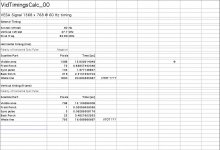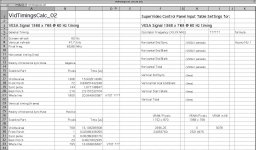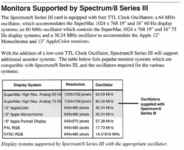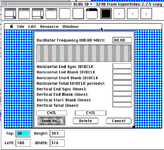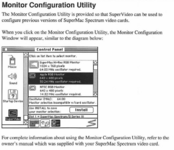Trash80toHP_Mini
NIGHT STALKER
The dearth of information on these cards on LowendMac is apalling.
Spectrum/24 Series III
Spectrum/24 Series IV
Spectrum/24 Series V
Spectrum/24 PDQ
Spectrum/24 PDQ+
My card has the Spectrum24 Version 1.0 ROM c1989 . . .
. . . the standard 64MHz Oscillator (Crystal Can) on board for use with the FixedRes SuperMac 19" Monitor . . .
. . . a DIN8 connector on the back
Presumably the connector is intended for serial comms with a High End MultiSync like my . . .
. . . Radius PrecisionView 2150 with HD-15, BNC and DIN8 (specified as serial) connections . . .
. . . MAG M21XF which has HD-15, DA-19 and DIN8 (presumably serial) connections.
The Spectrum/24™ User's Manual that came with the card is c1989 . . .
. . . The Control Panel/Driver setup is Version 2.7 from 1990 . . .
The LowendMac info mentions the Spectrum24 Series IV card as having a Version 1.6 ROM and the Series V as having a Version 3.0 ROM (PPC Compatible)
Presumably, mine would be the Series III variant . . .
Here are the screen shots of from my card set up and running in the pet IIfx:
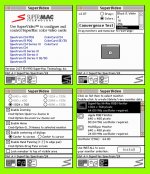
There's no mention of the Virtual Desktop, Zoom or Hand Panning capabilities of this series on LowendMac. A few things came immediately to mind when reading the manual. (YEP! I'm a RTFMin' Wooly Rhino from the Paleolithic CPM Era! [ ] ]'> ) If this thing does virtual desktops of 4096x1536x24bit and supports custom monitor settings as explained in the manual, this just may be a 1600x1200x24bit@60Hz Silver Bullet from the IIci era!
] ]'> ) If this thing does virtual desktops of 4096x1536x24bit and supports custom monitor settings as explained in the manual, this just may be a 1600x1200x24bit@60Hz Silver Bullet from the IIci era!
Not to mention the possibilities for 60Hz output at 480, 720 or even 1080p, all well under the 4096 x 1536 Virtualized Desktop capability of the card. Depending upon how, and how much, memory blocking is done/works for the expanded desktop virtualization, the tools are right there in the software to make the attempt to spec all those resolutions as custom monitor settings.
I think I need to get a 24MHz Crystal for playing around with the MultiSyncs and setting up some custom monitor settings. :approve:
The VRAM on board is TC524256Z-10 and there are six banks of 4 SIPs ea. 24 in total. That info alone ought so tell the tale of the maximum pixel count possible in 24 bit or 16bit modes, but I never did figure out how to do the conversions. What are the VRAM induced limitations of my pixellated dreams for this lil' puppy?
Has anyone already played around with one of these cards already? :?:
Spectrum/24 Series III
Spectrum/24 Series IV
Spectrum/24 Series V
Spectrum/24 PDQ
Spectrum/24 PDQ+
My card has the Spectrum24 Version 1.0 ROM c1989 . . .
. . . the standard 64MHz Oscillator (Crystal Can) on board for use with the FixedRes SuperMac 19" Monitor . . .
. . . a DIN8 connector on the back
Presumably the connector is intended for serial comms with a High End MultiSync like my . . .
. . . Radius PrecisionView 2150 with HD-15, BNC and DIN8 (specified as serial) connections . . .
. . . MAG M21XF which has HD-15, DA-19 and DIN8 (presumably serial) connections.
The Spectrum/24™ User's Manual that came with the card is c1989 . . .
. . . The Control Panel/Driver setup is Version 2.7 from 1990 . . .
The LowendMac info mentions the Spectrum24 Series IV card as having a Version 1.6 ROM and the Series V as having a Version 3.0 ROM (PPC Compatible)
Presumably, mine would be the Series III variant . . .
I can test this easily enough when I get the chance, no mention of ROM rev requirements in the Series III article, so we'll see.The SuperMac Spectrum/24 Series III card is a 12" NuBus card compatible with 680x0- and PowerPC-based Macs running up to Mac OS 8.1. It may be compatible with higher versions of the Mac OS, but no information for Mac OS 8.5-8.6 is available at this time, and it's doubtful that the card is compatible with Mac OS 9.
Here are the screen shots of from my card set up and running in the pet IIfx:

There's no mention of the Virtual Desktop, Zoom or Hand Panning capabilities of this series on LowendMac. A few things came immediately to mind when reading the manual. (YEP! I'm a RTFMin' Wooly Rhino from the Paleolithic CPM Era! [
Not to mention the possibilities for 60Hz output at 480, 720 or even 1080p, all well under the 4096 x 1536 Virtualized Desktop capability of the card. Depending upon how, and how much, memory blocking is done/works for the expanded desktop virtualization, the tools are right there in the software to make the attempt to spec all those resolutions as custom monitor settings.
I think I need to get a 24MHz Crystal for playing around with the MultiSyncs and setting up some custom monitor settings. :approve:
The VRAM on board is TC524256Z-10 and there are six banks of 4 SIPs ea. 24 in total. That info alone ought so tell the tale of the maximum pixel count possible in 24 bit or 16bit modes, but I never did figure out how to do the conversions. What are the VRAM induced limitations of my pixellated dreams for this lil' puppy?
Has anyone already played around with one of these cards already? :?:

